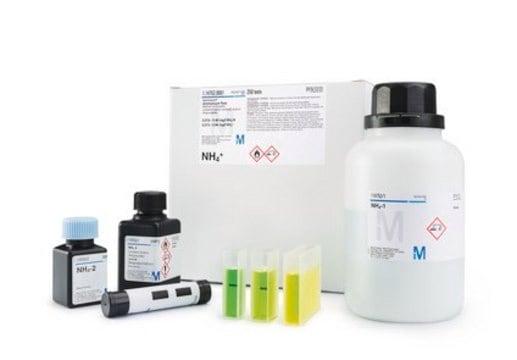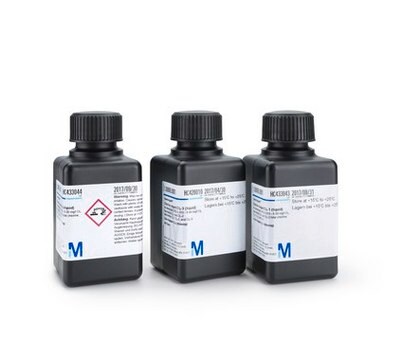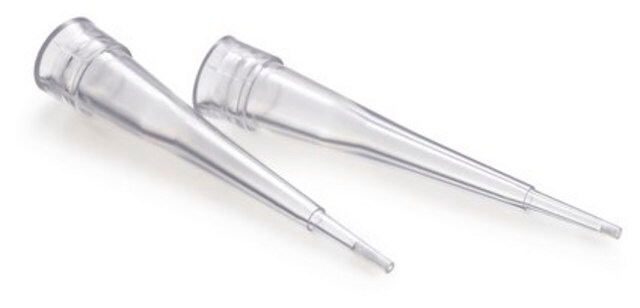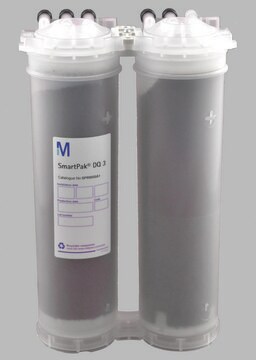1.00595
Chlorine Test, photometric
photometric, 0.030-6.00 mg/L (Cl2), Spectroquant®
About This Item
Produits recommandés
product name
Chlorine Cell Test, photometric, 0.030-6.00 mg/L (Cl2), Spectroquant®
Gamme de produits
Spectroquant®
Niveau de qualité
Utilisation
sufficient for 200 tests (free chlorine)
Analyte(s) spécifique(s)
chlorine
Plage de mesure
0.030-6.00 mg/L (Cl2)
Technique(s)
photometry: suitable
Compatibilité
for use with Spectroquant® Move 100
for use with Spectroquant® Nova 60 A
for use with Spectroquant® Prove 100
for use with Spectroquant® Prove 300
for use with Spectroquant® Prove 600
Méthode de détection
photometric (DPD)
Température de stockage
15-25°C
Description générale
This Spectroquant® Chlorine test allows the accurate quantification of chlorine in various waters. Chlorinated disinfectants are still in common use all over the world, their major applications being in the chlorination of drinking water and swimming pools. In weakly acidic solution free chlorine reacts with dipropyl-p-phenylenediamine (DPD) to form a red-violet dye that is determined photometrically.
The method is analogous to EPA 330.5, APHA 4500-Cl2 G, and DIN EN ISO 7393-2.
All our Cell and Reagent Test Kits are equipped with the unique Live ID (2D barcode) which allows seamless method recognition and contains essential information such as lot number, expiry date, and automatic calibration updates.
The Spectroquant® Cell Tests come with prefilled 16 mm round cells as well as all the required reagents to perform the analysis according to the procedure described in the accompanying instruction leaflet.
Application
- Sustainable lindane waste remediation: Surfactant-driven residual DNAPL extraction and oxidation in a real landfill (LIFE SURFING).: This study uses a chlorine cell test to assess the effectiveness of surfactant-driven extraction and oxidation processes for the remediation of lindane waste in a landfill, highlighting innovative environmental cleanup methods (Fernández et al., 2024).
- Disinfectant-induced ammonia oxidation disruption in microbial N-cycling process in aquatic ecosystem after the COVID-19 outbreak.: Utilizes chlorine cell tests to study the impact of disinfectants on microbial nitrogen cycling in aquatic systems, providing critical insights into environmental effects of increased disinfectant use during the pandemic (Yang et al., 2024).
Informations légales
Mention d'avertissement
Danger
Mentions de danger
Conseils de prudence
Classification des risques
Eye Irrit. 2 - Repr. 1B
Code de la classe de stockage
6.1D - Non-combustible, acute toxic Cat.3 / toxic hazardous materials or hazardous materials causing chronic effects
Classe de danger pour l'eau (WGK)
WGK 2
Point d'éclair (°F)
Not applicable
Point d'éclair (°C)
Not applicable
Certificats d'analyse (COA)
Recherchez un Certificats d'analyse (COA) en saisissant le numéro de lot du produit. Les numéros de lot figurent sur l'étiquette du produit après les mots "Lot" ou "Batch".
Déjà en possession de ce produit ?
Retrouvez la documentation relative aux produits que vous avez récemment achetés dans la Bibliothèque de documents.
Protocoles
Preparation of a standard solution for free Chlorine according to DIN EN ISO 7393
AQA Standard for free chlorine - Preparation of a standard solution for free chlorine
Contenu apparenté
AQA Standard for free chlorine - Preparation of a standard solution for free chlorine
Notre équipe de scientifiques dispose d'une expérience dans tous les secteurs de la recherche, notamment en sciences de la vie, science des matériaux, synthèse chimique, chromatographie, analyse et dans de nombreux autres domaines..
Contacter notre Service technique





